

How to SEO your WordPress Categories and Tag Pages. Find and submit your sitemap - Using themes - Using Shopify - Shopify Help Center. All Shopify stores automatically generate a sitemap.xml file that contains links to all your products, product images, pages, collections, and blog posts.
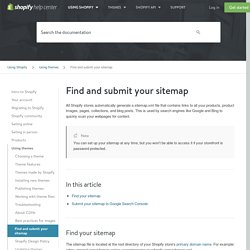
This is used by search engines like Google and Bing to quickly scan your webpages for content. Note You can set up your sitemap at any time, but you won't be able to access it if your storefront is password protected. The sitemap file is located at the root directory of your Shopify store's primary domain name. For example: johns-apparel.com/sitemap.xml or yourstorename.myshopify.com/sitemap.xml. This sitemap file that Shopify generates links to separate sitemaps for your Products, Collections, Blogs, and Pages. Once verified, go to and sign in if it prompts you.Click the name of the website who's sitemap you want to submit: Click the Sitemaps button: Click ADD/TEST SITEMAP Enter "sitemap.xml" and click Submit Sitemap. This Is Why You Should Use WordPress for Your Ecommerce Site.
Ecommerce started to grow strongly in the last 5 years and it’s in a continuous ascent, as now powers 45,4% percentage of the entire web.
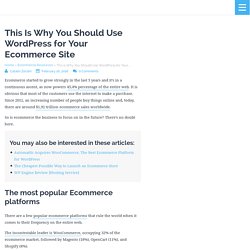
It is obvious that most of the customers use the internet to make a purchase. Since 2012, an increasing number of people buy things online and, today, there are around $1,92 trillion ecommerce sales worldwide. So is ecommerce the business to focus on in the future? There’s no doubt here. The most popular Ecommerce platforms There are a few popular ecommerce platforms that rule the world when it comes to their frequency on the entire web. The incontestable leader is WooCommerce, occupying 32% of the ecommerce market, followed by Magento (18%), OpenCart (11%), and Shopify (8%). WooCommerce is used on 176,223 websites, whilst Magento and OpenCart are used on 102,514 and 60,133, respectively. Why is WooCommerce the leader? You’re probably asking now what’s so special about WooCommerce and why is it the first in the world. How to Optimize Your Shopify Store for Search Engines Using Screaming Frog SEO Spider 2.30.
9 Examples Of Link-Worthy Resources For E-Commerce Sites. Analytics Academy. A Complete Guide to Title Tags in Magento. May 13th, 2015 A Complete Guide to Title Tags in Magento Category:Magento SEO | Posted By Mai Erne at 10:00 AM As you may already know, the title tag is one of the most important on-page elements for SEO.

The title tag is as the word indicates the title of the page (If you dont know about title tags, read this article on how to write good title tags). A Comprehensive Approach to Magento SEO. May 23rd, 2015 A Comprehensive Approach to Magento SEO Category:Magento SEO | Posted By Mai Erne at 10:00 AM In this blog post, you’ll learn how to develop an effective keyword strategy for your Magento website, some general Magento admin panel configurations to make it more Magento SEO friendly, how to create the robot.txt and sitemap.xml files, and how to set up Google Analytics for a Magento store.

One of the hallmarks of Magento, which distinguishes it from other eCommerce CMSs, is the extent of customization it offers. In Magento, unlike most other eCommerce CMSs, we have the flexibility to customize every page, every product, and every snippet of code within its framework for search engines. In this series, we’ll cover all the fundamentals you need to know to best equip your Magento website to rank well in search engine result pages, giving a boost to your sales and revenues.
All SEO optimization campaigns start with effective planning of a keyword strategy. 7 Common Magento SEO Mistakes. May 18th, 2015 Category:Magento SEO | Posted By Mai Erne at 10:00 AM 7 Common Magento SEO Mistakes When dealing with Magento store’s SEO, these are the 7 most common Magento mistakes that you may encounter.
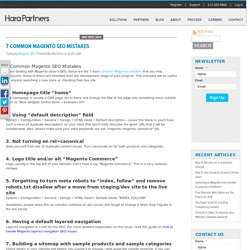
Some of these are inherited from the development stage of your projects. This checklist will be useful for anyone launching a new store or checking their live site. 1. The homepage is usually a CMS page. 2. System > Configuration > General > Design > HTML Head > Default description – Leave this blank or you’ll have such a mess of duplicate descriptions on your store that don’t really describe the given URL that it will be unbelievable. 3. Save yourself from lots of duplicate content issues. Magento Layered Navigation SEO - Tutorial. Layered navigation, a feature available in Magento without any extensions is commonly used by many merchants around the world.
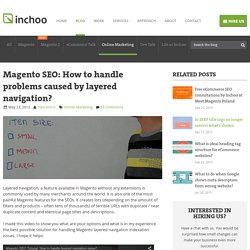
It is also one of the most painful Magento features for the SEOs. It creates lots (depending on the amount of filters and products – often tens of thousands) of terrible URLs with duplicate / near duplicate content and identical page titles and descriptions. Reducing Bounce Rate In eCommerce. Let’s say, a user visited your website.
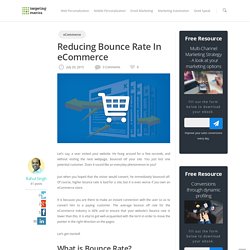
He hung around for a few seconds, and without visiting the next webpage, bounced off your site. You just lost one potential customer. Does it sound like an everyday phenomenon to you? Just when you hoped that the visitor would convert, he immediately bounced off. Of course, higher bounce rate is bad for a site, but it is even worse if you own an eCommerce store. Magento Seo Suite Ultimate - Best Magento SEO extension by Mageworx. How Google Shopping & Product Search Works. Google: AdWords: Product Listing Ads. Magento Search Engine Optimization. Optimise Web's Mass 301 Redirects for 404 Pages. Mass / Bulk Redirects (301, 302, or any status) for Magento 404 Pages Magento has an internal URL Rewrite Management system.
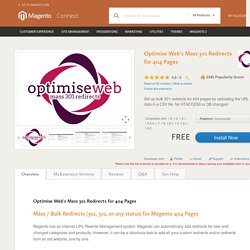
Magento can automatically add redirects for new and changed categories and products. However, it can be a laborious task to add all your custom redirects and/or redirects from an old website, one by one. 8 Ecommerce SEO Best Practices. Working at a stellar online marketing agency like Wpromote, I have created SEO campaigns for a variety of Ecommerce brands.
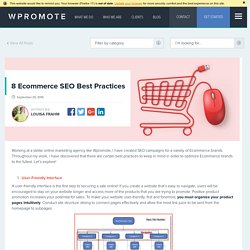
Throughout my work, I have discovered that there are certain best practices to keep in mind in order to optimize Ecommerce brands to the fullest. Let’s explore! User-Friendly Interface A user-friendly interface is the first step to securing a sale online! If you create a website that’s easy to navigate, users will be encouraged to stay on your website longer and access more of the products that you are trying to promote. Organize your product pages how users would want to see them, arranging categories in order of importance. Content Marketing Strategy. 7 Critical SEO Errors of E-commerce Websites. It’s common for online merchants to think that by simply listing hundreds or even thousands of products on their e-commerce website, search engine traffic will start rolling in.
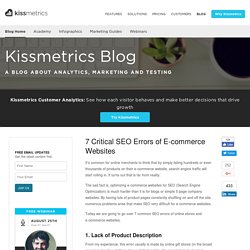
It turns out that is far from reality. The sad fact is, optimizing e-commerce websites for SEO (Search Engine Optimization) is much harder than it is for blogs or simple 5 page company websites. By having lots of product pages constantly shuffling on and off the site, numerous problems arise that make SEO very difficult for e-commerce websites. How To Speed Up Magento. After coming back from Magento Live in London and listening to Hedley Aylotts fantastic presentation on Magento load speeds I decided to do a little test on a standard Magento installation to see how fast we could get it to load up – with minimal effort (less than 3 seconds hopefully!!). Our Test Subject Our test subject for the day was a standard 1.7.0.2 Magento Community Edition installation without sample data. We placed this installation on one of our servers and prepped it for development (refreshed indexed / turned cache off).
We then christened this installation Fox 1 and got down to work. Testing Criteria The main aim of this experiment was to reduce the load speed with as few tweaks as possible – mainly using the inbuilt optimisation methods supplied with Magento.